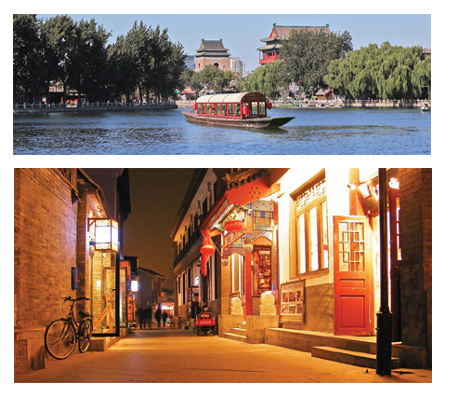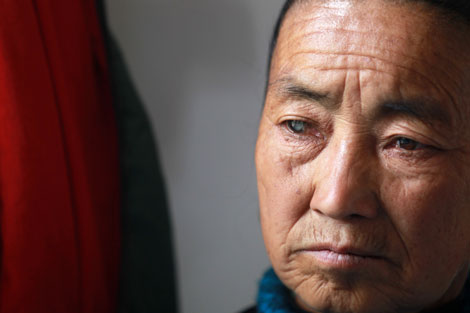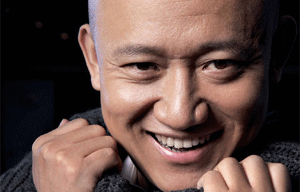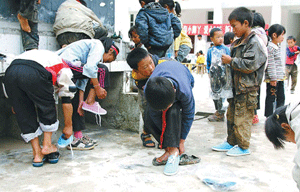Basking in old glory
Updated: 2011-11-18 08:53
By Lin Jing (China Daily European Weekly)
|
|||||||||
|
Above: Shichahai Lake is looking to combine its rich tradition and modern life to achieve robust business growth. provided to China Daily Below: Yandai Xiejie is home to many souvenir stores with cultural and innovative products. Fang Song / for China Daily |
Shichahai looks to the past for the future
Unlike many other regions of China that are shedding their old cloak to attract overseas investment and tourists, a popular lake district in Beijing is looking to use more of its rich and ancient tradition for growth. Shichahai Lake traces its history to the Jin Dynasty (AD 265-420) and is also home to over 40 cultural relics, including many princely mansions from the Qing Dynasty (1644-1911) period. It is also the only open water space in downtown Beijing and one of the most popular recreation spots in the capital. But what sets Shichahai apart is that one does not see the frenetic pace of construction that is visible elsewhere in the capital city. Rather the area has a semblance of calm and tranquility associated with it.
Lin Xiaomu, director of the Shichahai Scenic Area Administrative Office, which oversees the development of the area, says the lake district can achieve robust economic growth if it starts relying more on its rich tradition and culture.
"Shichahai district must try to market itself by combining tradition and modern life," she says.
Spread over 323 hectares with three small lakes - Qianhai, Houhai and Xihai - it accounts for a fourth of the cultural relics in downtown Beijing.
It is also the biggest culture-themed business zone in Xicheng district, one of the administrative region of Beijing, with 1,533 businesses spread around the lake raking in revenue of more than 12.77 billion yuan ($2 billion, 1.49 billion euros) in 2010. During the past five years, tax revenues from the region have increased six-fold, according to information provided by the Xicheng district government.
During the first three months of this year, the average tourist traffic in the area was 2,695 people an hour, 18 percent higher than the same period in 2010. International tourists accounted for 5 percent of the total, according to official figures.
Jeremy Scaramuzzi, who came from the United States two years ago and teaches language and history at Tsinghua International School, is a frequent visitor to Houhai.
He likes to come to Houhai in the afternoon, have dinner with his friends beside the lake, and enjoy the nightlife afterward. "For visitors to Beijing, it is the most happening place."
One of the main attractions in Shichahai has been the way it used its old houses for maximum advantage. In 2007, the Xicheng district government invested 3 billion yuan for a reconstruction project in the lake area.
"The project mainly focused on infrastructure, including road paving, utilities, maintenance and planting trees around the lake," Lin from the administrative office says.
After that, the 260-meter-long street was turned into a commercial pedestrian street, with stores selling traditional Chinese artifacts such as smoking sets, lanterns, kites and scissor-cuts.
"We want to revitalize the traditional shopping experience for consumers when they walk on the old commercial street," Lin says.
Many local stores as well as restaurants have benefited from the commercial zone. There are more than 160 bars along the lake. Most of them rent old Beijing houses, and compete with each other in offering unique styles and services. Some of the places are quiet enough for chatting with friends, while others provide karaoke equipment for people to showcase their talent.
Lin says that there are also several important cultural relics, like the former residence of Soong Ching-ling, Yinding Bridge, the Bell and Drum towers, and Prince Gong's Mansion, and some other Beijing traditional courtyard houses.
Approved by the State Council in 2000, the area was listed as the largest of the 25 protected areas for culture and history in Beijing.
In June 2003, Starbucks opened its first outlet in the area on Lotus Lane. Since then, it has become the focal point of the area and an important landmark with its distinct Chinese architectural style, red wooden pillars and grey tiled roof.
"The combination of mature tourism, bar culture and restaurants is what attracted us to Houhai," says Li Jing, PR manager with Starbucks (China) Co Ltd.
"Nearly 30 million tourists visit Houhai every year. That in itself is a good endorsement for brand promotion," says Zhu Haiqin, owner and co-founder of Yunhaiyao Club, a Yunnan cuisine restaurant in Houhai.
In October 2009, Zhu and three friends opened the restaurant in Houhai with an investment of 2 million yuan.
Zhu says that the urban advantage of Houhai has helped boost business.
"Unlike other new commercial streets, Houhai has a longer history and better cultural foundation. Many shops here have hundreds of years of history. The traditional architecture here is also better preserved than in other places. You can find some typical scenery and recreation spots around Houhai, such as skating on the lake in the winter and riding tricycles."
The restaurant has 35 employees and the daily income is about 20,000 yuan. Its annual sales grew by nearly 30 percent last year.
With business booming, Zhu set up a second restaurant in Zhongguancun in 2010, and is currently thinking of having a third one.
However, Shichahai does not want to be known only as a bar and nightlife area for visitors. It is thinking of leveraging its traditional resources and becoming a major creative industry base.
According to the 12th Five-Year Plan (2011-2015) of Shichahai area, the Xicheng district government will further explore the cultural and historical value through infrastructure and service improvement, while upgrading the functions of the scenic area by encouraging cultural industries and promoting the Shichahai brand.
Wang Ning, acting chief of Xicheng district, said in October that the area should focus on five aspects: royal waters, cultural museums, specialty shopping, theme hotels, as well as cultural and commerce festivals.
"We hope that in the future, there will gradually be more cultural elements in this area to promote local business," Lin says.
It is also planning to build a museum in Yandai Xiejie, an alley in the lake area that has been in existence for 800 years, for exhibiting historical and cultural relics in the Shichahai area. The 1,000-square-meter museum is likely to be open sometime next year.
With Beijing striving to get the geographic axis of the city, which connects the Temple of Heaven, the Forbidden City and the Temple of Earth, to be declared a cultural heritage site by the United Nations Educational, Scientific, and Cultural Organization as early as 2013, the Shichahai area, which is part of the axis, will get an automatic face-lift, Lin says.
She says her office will encourage more creative businesses to set up facilities in the Yandai Xiejie area.
"Stalls and street peddlers degrade the image and impair consumer experience of the district. That is not what we want. We want to encourage more creative and exquisite retailers to come to this area."
Yandai Xiejie has changed from a street full of audio equipment stores about 20 years ago to souvenir stores with cultural and innovative products.
Lin says that currently they do not have any specific policies or regulations for business guidance, but she believes that as long as the environment and infrastructure keeps improving, retailers will come.
On Oct 26, Huguosi snack street opened after two years' of reconstruction. The 600-meter-long street has a history of 800 years, dating back to the Yuan Dynasty (1271-1368).
In the Ming (1368-1644) and Qing (1644-1911) dynasties, it was also a famous business street in Beijing, with many stores selling snacks, antiques and clocks.
Now the street has 70 percent of its businesses coming from special snacks and 30 percent from artifacts such as facial make-up used in Peking opera.
The reconstruction project began in 2009 with an investment of 130 million yuan. It was aimed to repair the infrastructure and build new parking lots and more public toilets. A shopping mall, Huguo Xintiandi, will also come up as part of the plan next August.
Wang Fujun, an official in charge of the district's commerce industry, says that the newly opened Huguosi street will no longer be the memories of old Beijingers, but a multifunctional zone for new Beijing life.
The new shopping mall will take up 10,000 square meters, with a hotel, various restaurants and a Pioneer theater.
Tian Xuesong, senior project manager with Hong Kong SPACE Creative Holdings Ltd, the company in charge of operation and planning the new shopping mall, says that unlike other tourist attractions like Wangfujing and Qianmen, the new commercial zone around Huguo Temple aims to present a strong comparison of modern and traditional lifestyles.
At present, there are many districts mixing Beijing local styles with Western restaurants and bars, such as Nanluo Guxiang in Dongcheng district and Wudaoying Hutong near the Lama Temple.
Though many of these came up much later than Houhai, they have become popular destinations for foreign visitors and local youngsters.
Lin, however, says that though similar to one another, Shichahai does have its own advantages when compared with these newly built streets.
"Though all these areas attract consumers with local Beijing culture, Shichahai has more local Beijingers, hutongs and, most importantly, the only open lake in the urban Beijing. These cannot be easily copied by late-comers.
"The different views of the lake at day and night represent irreplaceable sceneries and memories for visitors, especially foreigners."












